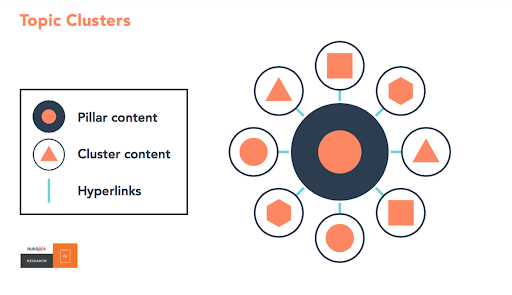How NOT to Use Topic Clusters in Your Content Strategy [VIDEO]
Written by
Topic clusters are a valuable SEO tool. However, knowing exactly what topic clusters are — and what they aren't — is key to maximizing your inbound marketing efforts.
As B2B marketers, we all want to cut through the noise within search engines and generate high-quality leads. Topic clusters are a way to demonstrate topic expertise and help improve a site’s search rankings for several core topics.

A pillar page features aspects of a key topic (a product or service, for instance) that’s relevant to your company. Topic clusters serve as subcategories that cover — in depth — keywords related to that topic area. Understanding the differences and benefits can be confusing.
What are topic clusters NOT meant to do? Organize ALL of your content.
When you have a better understanding of topic clusters, you’ll feel empowered to use them to improve SEO. Plus, you won’t stress about fitting everything you publish into a topic cluster (not every subject is a good fit, and that’s ok).
Watch the Weidert Wednesday video above (or follow the transcript below), and I’ll explain how to properly use SEO topic clusters — and what NOT to attempt with this inbound marketing tool.
Weidert Wednesday: How NOT to Use Topic Clusters in Your Content Strategy [TRANSCRIPT]
Topic clusters have become a very popular tactic in content marketing, and for good reason. They can be really effective. But do you actually know what they are and what they aren’t?
Topic clusters came to be as an SEO tool. The whole purpose of utilizing a topic cluster is to choose, create, and organize content in a way that will show authority to Google so that you can rank for an important, difficult competitive keyword that sits in the middle of your topic cluster. That is why this whole concept was created in the first place.
Topic Clusters — What They Are… and Are Not
What topic clusters can often become is this be-all, end-all organizational tool for everything you need to talk about in content marketing from A to Z. And that's really not what they're for.
When you have a keyword that is competitive, it has high search volume, and it's really important to your business, you need a strategy to rank for that — how you're going to prove to Google that you are an authority in that area. That is when you utilize a topic cluster method so that you can talk about this area in a comprehensive way using all the subtopics that you would build in a cluster.
The last thing you should do with a topic cluster is force it. It's not going to be appropriate for every type of topic area you may need to cover in some way in your content strategy.
When to Use Topic Clusters
You should really only utilize a topic cluster when you're using it for the purposes of SEO:
When your focus is on organic traffic, you need to rank for something important, and you know the search demand is there. That's when you can utilize a topic cluster method.
If you want to learn more about additional tactics you can utilize alongside your topic cluster strategy, I talked really extensively about SEO and content strategy at our Experience Inbound conference, and you can watch the on-demand webinar here to see the whole thing. (It's really awesome. You should check it out.)
Keep the SEO learning going!
Get a better understanding of SEO and why it’s an essential component of any company’s marketing strategy. Watch our free webinar, Demystifying Search Engine Optimization and start being found in online searches by your ideal prospects.
Subscribe To Our Blog
Information. Insights. Ideas. Get notified every time a new Weidert Group blog article is published – subscribe now!
You May Also Like...

Artificial Intelligence
Revenue-Driving B2B Content Marketing Strategy with Andy Crestodina

Artificial Intelligence
AI Agents Are Here—How Smart Businesses Are Using Them Now

Inbound Marketing
Podcasting Playbook: What We Learned After 100 Days of Running a B2B Podcast
Accelerate Your Growth with
Weidert Group
If you’re ready to explore a partnership, request a personalized consultation with our team.

